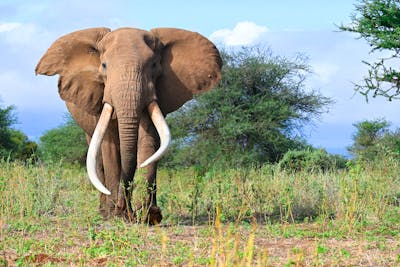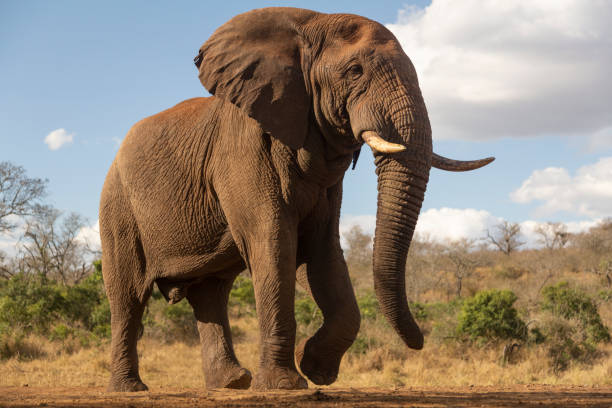Table of Contents
Scientific Classification
| Kingdom | Animalia |
| Phylum | Chordata |
| Class | Mammalia |
| Order | Proboscidea |
| Family | Elephantidae |
| Genus | Loxodonta |
| Species | Loxodonta africana |
| Scientific Name | Loxodonta africana |
Description
The African Bush Elephant (Loxodonta africana) holds the title of the largest land animal on the planet. Renowned for their size and intelligence, these elephants have a sophisticated social structure. They are among the most recognizable animals in the African wilderness. With their grey, wrinkled skin, these magnificent creatures are easily identifiable. Their large, fan-like ears serve to regulate their body temperature. Additionally, they possess long, curved ivory tusks.
Adult males, referred to as bulls, can stand between 3 to 4 meters (10 to 13 feet) tall at the shoulder and typically weigh between 4,500 and 6,800 kg (10,000 to 15,000 lbs). Females, known as cows, are somewhat smaller but still quite impressive. Their trunks function like elongated noses and upper lips, assisting them in various tasks such as drinking, foraging for food, and even communicating. Furthermore, trunks play a significant role in social bonding among elephants.
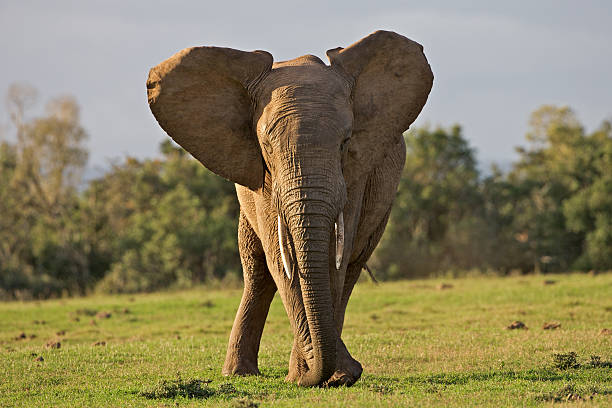
Distribution
African Bush Elephants inhabit various regions across sub-Saharan Africa, primarily residing in national parks, savannas, forests, and wetlands. Their distribution includes:
Botswana
Kenya
Tanzania
South Africa
Zambia
Namibia
Historically, they roamed vast territories freely, but human activities and habitat destruction have confined them to national parks and protected areas.
Habitat
These elephants flourish in a variety of ecosystems, such as:
Savannas – Expansive grasslands dotted with trees, which serve as their primary habitat.
Woodlands – Offering both shelter and a range of food options.
Swamps and Wetlands – Providing easy access to plentiful water sources.
Dense Forests – While less common, some groups can be found in rainforests.
African Bush Elephants are massive creatures. They require vast areas rich in food and water, leading them to travel great distances in search of these essentials.
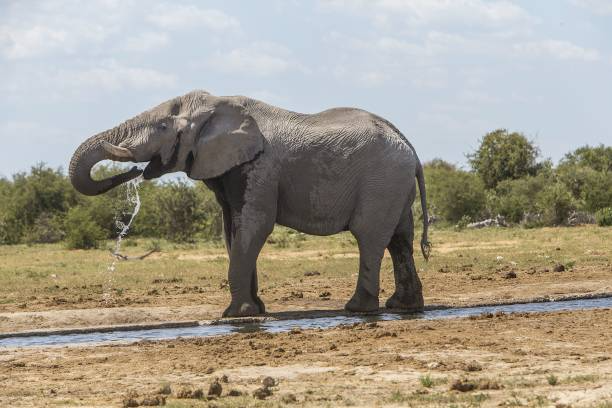
Diet
African Bush Elephants are herbivores that primarily eat:
Grass – Their main food source during the wet season.
Leaves and Bark – Especially important in dry seasons when grass is limited.
Fruits and Roots – These offer vital nutrients.
Shrubs and Tree Branches – They use their powerful trunks and tusks to break these down.
An elephant consumes around 150 to 300 kg (330 to 660 lbs) of vegetation daily, which means they need to forage continuously to sustain their massive bodies.
Behavior
- African Bush Elephants are intelligent and social creatures, displaying deep emotions and strong family bonds.
- Matriarchal Societies – A knowledgeable female leads the elephant herds, which consist of mothers, aunts, and their young calves.
- Mourning the Dead – They engage in unique rituals, often revisiting the bones of their deceased loved ones.
- Communication – They use a combination of sounds, body language, and infrasound to communicate over long distances.
- Mud Bathing – This behavior helps protect their skin from sunburn and insect bites.
- Playfulness – Young calves are especially playful, often engaging in mock fights and social interactions.
Lifespan
In the wild, African Bush Elephants can live for 60 to 70 years, which makes them among the longest-living mammals. However, factors like poaching, habitat loss, and conflicts with humans can significantly reduce their lifespan.
Reproduction and Lifecycle
- Reproduction in African Bush Elephants follows a slow yet organized cycle:
- Gestation Period – Lasting around 22 months, this is the longest gestation of any land mammal.
- Birth – A single calf is born, weighing roughly 90 to 120 kg (200 to 260 lbs).
- Maternal Care – Calves rely on their mothers and the herd for protection and nourishment.
- Weaning – This usually happens between the ages of 3 to 5 years.
- Maturity – Females reach reproductive age at about 10 to 12 years, while males achieve independence at 15 to 20 years.
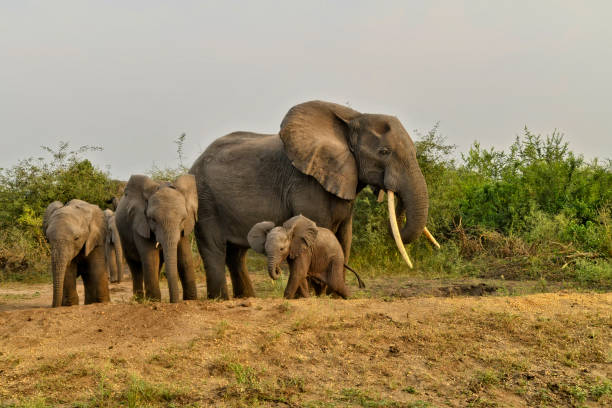
Predators
Due to their immense size, adult African Bush Elephants have few natural predators. However, vulnerable young calves may fall prey to:
- Lions – Occasionally targeting young or weak individuals.
- Hyenas – Opportunistic predators of elephant calves.
- Crocodiles – Ambushing elephants at waterholes.
- Humans – The greatest threat due to poaching and habitat destruction.
Adaptations
- African Bush Elephants possess several key adaptations that help them thrive in their environment:
- Large Ears – These help regulate body temperature by releasing excess heat.
- Powerful Trunk – This versatile tool is essential for feeding, drinking, and communicating.
- Strong Tusks – They serve multiple purposes, including defense, digging, and stripping bark from trees.
- Thick Skin – This provides protection against injuries, sunburn, and extreme weather conditions.
- Complex Social Structure – This fosters survival through teamwork and collective decision-making.
Conservation Status
- The African Bush Elephant is listed as Endangered by the IUCN. This classification arises from various
- Threats:
- Poaching – Illegal hunting for ivory continues to be a major concern.
- Habitat Loss – The expansion of agriculture and urban areas diminishes their natural habitat.
- Human-Wildlife Conflict – Struggles over land and resources result in harmful encounters.
- Climate Change – Changes in rainfall patterns impact the availability of water and food.
Conservation Efforts:
- Anti-Poaching Measures – Enhancing patrols and enforcing wildlife protection laws more rigorously.
- Protected Reserves – Creating national parks and conservation zones.
- Community Involvement – Raising awareness and engaging local communities in conservation initiatives.
- Global Awareness Campaigns – Promoting bans on the ivory trade and advocating for stronger legal protections.
Conclusion
The African Bush Elephant represents strength, intelligence, and resilience. As the largest land animal, it plays a crucial role in maintaining ecosystems. It helps to balance vegetation and creates water access points for various species. Unfortunately, these gentle giants encounter many challenges that jeopardize their survival. With ongoing conservation efforts and increased global awareness, there is hope for their survival for future generations.
